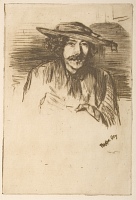Etchings Institutions search term: caxton club
Whistler with a hat | ||
| Number: | 44 | |
| Date: | 1859 | |
| Medium: | drypoint | |
| Size: | 229 x 154 mm | |
| Signed: | 'Whistler.' at lower right | |
| Inscribed: | '1859.' at lower right | |
| Set/Publication: | 'Cancelled Plates', 1879 | |
| No. of States: | 3 | |
| Known impressions: | 36 | |
| Catalogues: | K.54; M.54; T.65; W.52 | |
| Impressions taken from this plate (36) | ||
PUBLICATION
EXHIBITIONS
Later, examples were shown in exhibitions organised by private clubs such as the Union League Club in New York - a 'Trial proof' lent by Samuel Putnam Avery (1822-1904) (
 ) - and the Caxton Club in Chicago, lent by Bryan Lathrop (1844-1916) (
) - and the Caxton Club in Chicago, lent by Bryan Lathrop (1844-1916) ( ). 16
). 16
Impressions also starred in international exhibitions, including the World's Columbian Exposition in 1893, lent by Edward Guthrie Kennedy (1849-1932), as well as Glasgow in 1901, lent by James Cox-Cox (ca 1849- d.1901), and Philadelphia in 1902, lent by Howard Mansfield (1849-1938) (
 ). 17
). 17
Several print dealer's shows included important impressions from major collections. For instance, impressions of both the first and second states from the collection of Francis Seymour Haden, Sr (1818-1910) were shown by H. Wunderlich & Co. in New York in 1898 and bought, with the advice of Thomas Wilmer Dewing (1851-1938), by Charles Lang Freer (1856-1919) (
 ,
,  ). 18
). 18
Finally, impressions were shown in the principal Memorial Exhibitions after Whistler's death, including New York and Boston in 1904, and - lent by James Thomas Knowles (1831-1908) - in the London Memorial show in 1905 (
 ,
,  ). 19
). 19
15: A Collection of Engraved Portraits ..., Guildhall, London, 1872 (959); Liverpool 1874 (cat. no. 471).
16: New York 1881 (cat. no. 73); Chicago 1900 (cat. no. 48).
17: Chicago 1893 (cat. no. 2225); Glasgow 1901 (cat. no. 230); Philadelphia 1902 (cat. no. 47 (52)).
18: New York 1898 (cat. no. 49; see REFERENCES: EXHIBITIONS.
19: Boston 1904 (cat. no. 46); New York 1904a (cat. no. 54); London Mem. 1905 (cat. no. 52).
SALES & COLLECTORS
 ). 20
). 20
20: V&A Register of Prints, p. 32.
 ). Another impression was probably given to a fellow artist, and also may have been acquired by Avery, and returned to Whistler for signature in the early 1870s (
). Another impression was probably given to a fellow artist, and also may have been acquired by Avery, and returned to Whistler for signature in the early 1870s ( ). This may have been the impression Whistler mentioned to Fantin-Latour:
). This may have been the impression Whistler mentioned to Fantin-Latour: 21: Whistler to H. Fantin Latour, [August 1872], GUW #08041.
22: 'English Etching', The Standard, London, 25 April 1878, p. 2 (GUL PC1/94).
23: S. P. Avery to Whistler, 2 January [1879], GUW #00218.
24: Sotheby's, 22 April 1887 (lot 195).
In 1892, one 'trial proof' from the collection of Joshua Hutchinson Hutchinson (ca 1829 - d.1891), was bought after his death for £15.10.0 by the print dealers Deprez & Gutekunst, and a second for only £6.0.0. by Frederick Keppel (1845-1912) of F. Keppel & Co. 26 It is possible that the latter was the impression that Keppel still owned in 1928, and which passed to Boston Public Library (
 ).
).Whistler with a hat is perhaps the most attractive and definitive of Whistler's etched portraits. It is clear that what at first was considered a good, representative portrait that friends and family could keep as a memento, became much sought after and exhibited by major collectors and collections. Avery's impressions were given to New York Public Library, to help form the basis for their Print Department, while Charles Lang Freer (1856-1919), bought impressions of three different states, a cancelled state from Knoedler & Co. in 1893 (
 ), and two earlier states in 1898 (
), and two earlier states in 1898 ( ,
,  ), which were bequeathed to the Freer Gallery of Art in 1919.
), which were bequeathed to the Freer Gallery of Art in 1919.25: E. Gosselin to Whistler, 22 October 1887, GUW #01768.
 ), as did Thomas Glen Arthur (1858-1907)(
), as did Thomas Glen Arthur (1858-1907)( ). George Aloysius Lucas (1824-1909) bought a set (
). George Aloysius Lucas (1824-1909) bought a set ( ) and Boston Public Library also acquired a set (
) and Boston Public Library also acquired a set ( ). Finally, a set acquired by J. Littauer, Munich was sold to the Hamburger Kunsthalle in 1896 (
). Finally, a set acquired by J. Littauer, Munich was sold to the Hamburger Kunsthalle in 1896 ( ).
). ). She also had a second set of the cancelled etchings, which were trimmed to fit the envelopes containing the cancelled etching plates; this helped to identify the plates but not to preserve the etchings (
). She also had a second set of the cancelled etchings, which were trimmed to fit the envelopes containing the cancelled etching plates; this helped to identify the plates but not to preserve the etchings ( ).
). 27: Sotheby's, London, 13 December 1889 (lot 787 or 789)
